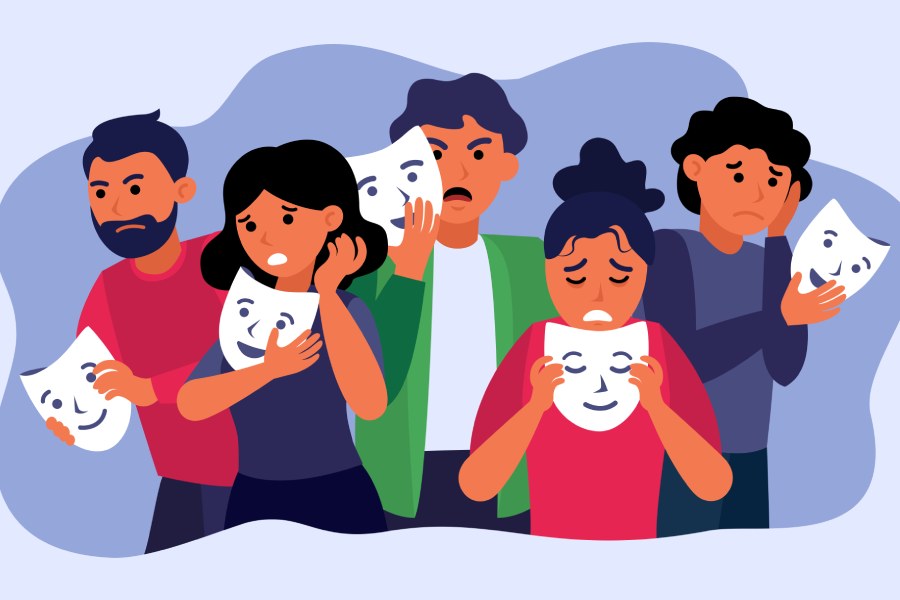We’ve all had times when we felt calm and handled tough situations with clear thinking, even when things were difficult. Conversely, there are times when our emotions seem to take on a life of their own, hijacking our rational thinking and leaving us feeling overwhelmed and out of sync. We’ve all been there — the rush of frustration when stuck in traffic, the surge of joy at a loved one’s success, or the pang of anxiety before a big presentation. These moments show how our feelings affect how we act and make choices every day.
These daily encounters with emotional regulation and dysregulation remind us of the intricate interplay between our thoughts, feelings, and actions. They show why it’s important to understand and improve our emotional skills. This helps us handle life’s ups and downs better, making us stronger and clearer-headed. Let’s dive deeper into the ways these concepts manifest in our daily lives and discover strategies for fostering emotional well-being amidst life’s complexities.
Also Check: Clinical psychologist in India
What is Emotional Regulation?
Emotions can range from happiness or pride, to sadness or anxiety. They also vary in intensity, with the same situation evoking different responses in different people. Imagine a roller coaster ride. For thrill-seekers, the twists and turns may bring feelings of exhilaration and joy, while for those with a fear of heights, it could trigger sensations of fear and anxiety. Additionally, even the same individual may experience varying emotions depending on the circumstances. For instance, riding the roller coaster with friends on a sunny day might evoke excitement, whereas riding it alone during a thunderstorm might evoke feelings of unease or apprehension.
According to the APA, “Emotional regulation refers to the ability of a person to control or adjust their emotions, either consciously or automatically.”
Emotional regulation isn’t just one simple function; rather, it involves a variety of processes and systems, such as attentional, cognitive, behavioral, social, and biological mechanisms. These processes work together to help individuals modulate, manage, or organize their emotions to adapt to their surroundings (Harms & Pollak, 2023, Gross & Thompson, 2007).
When we explicitly regulate our emotions, we’re actively monitoring and managing them using techniques like changing how we perceive situations, redirecting emotions towards a more positive outcome, or understanding how our behaviors influence our emotions. On the other hand, implicit emotion regulation happens without us consciously monitoring it, adjusting the intensity or duration of emotions automatically. This skill tends to improve as we grow older. Simply put, emotional regulation is about managing our feelings to cope better with life’s challenges and experiences (APA Dictionary of Psychology, n.d.)
What is Emotional Dysregulation
Emotional dysregulation refers to situations where individuals struggle to effectively manage their emotional reactions. This can manifest in various ways, such as heightened emotional responses, difficulty controlling emotions, or rapid mood swings. Additionally, challenges in emotion regulation may involve using conflicting strategies or struggling to choose the most appropriate approach to achieve a specific goal (Gratz & Roemer, 2004; Hilt et al., 2011).
Examples of maladaptive strategies include avoidance, rumination, denial, suppressing emotions, aggression, and externalizing emotions (Koçak et al., 2024).

Emotional Dysregulation Symptoms
1. Excessive intensity of emotional experiences
Individuals with emotional dysregulation often experience emotions with heightened intensity, escalating rapidly and intensely in response to triggers. This heightened emotional reactivity can lead to overwhelming feelings that are difficult to manage and may result in impulsive or erratic behavior.
2. Low level of emotional control
People struggling with emotional dysregulation may find it challenging to regulate their emotional responses effectively. They may have difficulty controlling impulses and reactions, leading to impulsive behaviors or emotional outbursts that are disproportionate to the situation at hand. This lack of emotional control can interfere with daily functioning and strain interpersonal relationships.
3. Rapid and unpredictable changes in emotional states
Emotional dysregulation is characterized by sudden shifts from one emotional state to another without an apparent trigger or reason. These mood swings can occur frequently and unpredictably, causing significant distress and making it difficult for individuals to maintain emotional stability. Such fluctuations can disrupt relationships and impair social and occupational functioning.
4. Inconsistent or conflicting use of emotion regulation strategies
Individuals with emotional dysregulation may struggle to consistently employ effective strategies to manage their emotions. They may use maladaptive coping mechanisms such as avoidance, rumination, denial, or emotional suppression inconsistently or in conflicting ways. This inconsistency in coping strategies can perpetuate emotional distress and hinder progress in achieving emotional regulation.
(Gratz & Roemer, 2004; Hilt et al., 2014)
Also find more details on mental health policies and programmes in the workplace
Importance of Identifying Emotions
1. Helps make sense of internal experiences
When we’re happy, sad, excited, or angry, our bodies react in different ways. For example, our heart might beat faster when we’re excited, or we might feel a knot in our stomach when we’re nervous. Recognizing these physical signs helps us understand our emotions better. (Craig, 2002)
2. Enhances social interactions
When we can identify how we’re feeling, it’s easier to explain it to others. If we’re upset, we can tell someone why, and they might be able to help us feel better. If we’re happy, we can share our joy with those around us. Being able to express our emotions helps us connect with others on a deeper level. (Barrett et al., 2016)
3. Helps navigate life’s challenges
Life can be challenging sometimes, but understanding our emotions helps us handle these tough times. When we’re sad, we might need some extra comfort or support. When we’re angry, we can find healthier ways to express ourselves instead of bottling up our feelings. Being aware of our emotions gives us the power to cope with difficulties and find solutions.
4. Helps build resilience
Emotional awareness gives us the ability to adapt to different situations, bounce back from setbacks, and build resilience. With emotional awareness, we can face whatever life throws our way with confidence and strength.
5. Continuous learning and growth
Just like any skill, understanding and managing our emotions takes practice. The more we learn about emotions and how they affect us, the better we become at handling them. By practicing mindfulness, talking to others, or seeking professional help if needed, we can strengthen our emotional awareness and improve our overall well-being.
6. Developing emotional literacy
Identifying emotions isn’t always easy, and that’s okay! It’s a skill that we can develop over time with practice and patience. By paying attention to how we feel, reflecting on our experiences, and seeking support when needed, we can become more confident in understanding and expressing our emotions. Remember, everyone learns at their own pace, so it’s important to be kind to ourselves along the way.
(Morie et al., 2022).
To conclude, understanding and regulating our emotions play crucial roles in navigating life’s complexities and nurturing our overall well-being. Emotional regulation involves a range of processes that help us manage our emotional states and cope with stressors. On the other hand, emotional dysregulation presents challenges like difficulty controlling reactions and unpredictable mood swings. Recognizing and labeling emotions not only boosts self-awareness but also enriches our relationships and builds resilience. Developing emotional literacy is very important and can empower us to lead more authentic and fulfilling lives by embracing our emotions and deepening self-understanding.
References:
APA Dictionary of Psychology. (n.d.). https://dictionary.apa.org/emotion-regulation
Barrett, L. F., Quigley, K. S., Hamilton, P., & Pool, E. (2016). The structure of emotion: evidence from the neuroimaging of emotion. Current Opinion in Behavioral Sciences, 11, 84-91.
Craig, A. D. (2002). How do you feel? Interoception: the sense of the physiological condition of the body. Nature Reviews Neuroscience, 3(8), 655-666.
Gratz, K. L., & Roemer, L. (2004). Multidimensional assessment of emotion regulation and dysregulation: Development, factor structure, and initial validation of the difficulties in emotion regulation scale. Journal of Psychopathology and Behavioral Assessment, 26(1), 41–54. https://doi.org/10.1023/B:JOBA.0000007455.08539.94
Gross, J. J., & Thompson, R. A. (2007). Emotion Regulation: Conceptual Foundations. In J. J. Gross (Ed.), Handbook of emotion regulation (pp. 3–24). The Guilford Press.
Harms, M. B., & Pollak, S. D. (2023). Emotion regulation. In Elsevier eBooks. https://doi.org/10.1016/b978-0-323-96023-6.00036-1
Hilt, L. M., Hanson, J. L., & Pollack, S. D. (2011). Emotion dysregulation. In B. Brown & M. Prinstein (Eds.), Encyclopedia of Adolescence (pp. 160–169). Elsevier.
Hilt, L. M., Leitzke, B. T., & Pollak, S. D. (2014). Cognitive control and rumination in youth: The importance of emotion. Journal of Experimental Psychopathology, 5(3), 302-313.
Koçak, Zeynep & Çağatay, Safiye. (2024). Childhood traumas and emotional eating: The mediating role of self-esteem, and emotion dysregulation. Current Psychology. 1-9. 10.1007/s12144-024-05953-2.
Morie, K., Crowley, M. J., Mayes, L. C., & Potenza, M. N. (2022). The process of emotion identification: Considerations for psychiatric disorders. Journal of Psychiatric Research, 148, 264–274. https://doi.org/10.1016/j.jpsychires.2022.01.053

